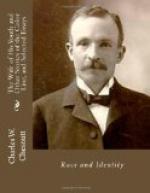Grace King’s “Story of New Orleans” makes the significant statement that the quadroon women of that city preferred white fathers for their children, in order that these latter might become white and thereby be qualified to enter the world of opportunity. More than one of the best families of Louisiana has a dark ancestral strain. A conspicuous American family of Southwestern extraction, which recently contributed a party to a brilliant international marriage, is known, by the well-informed, to be just exactly five generations removed from a Negro ancestor. One member of this family, a distinguished society leader, has been known, upon occasion, when some question of the rights or privileges of the colored race came up, to show a very noble sympathy for her distant kinsmen. If American prejudice permitted her and others to speak freely of her pedigree, what a tower of strength her name and influence would be to a despised and struggling race!
A distinguished American man of letters, now resident in Europe, who spent many years in North Carolina, has said to the writer that he had noted, in the course of a long life, at least a thousand instances of white persons known or suspected to possess a strain of Negro blood. An amusing instance of this sort occurred a year or two ago. It was announced through the newspapers, whose omniscience of course no one would question, that a certain great merchant of Chicago was a mulatto. This gentleman had a large dry goods trade in the South, notably in Texas. Shortly after the publication of the item reflecting on the immaculateness of the merchant’s descent, there appeared in the Texas newspapers, among the advertising matter, a statement from the Chicago merchant characterizing the rumor as a malicious falsehood, concocted by his rivals in business, and incidentally calling attention to the excellent bargains offered to retailers and jobbers at his great emporium. A counter-illustration is found in the case of a certain bishop, recently elected, of the African Methodist Episcopal Church, who is accused of being a white man. A colored editor who possesses the saving grace of humor, along with other talents of a high order, gravely observed, in discussing this rumor, that “the poor man could not help it, even if he were white, and that a fact for which he was in no wise responsible should not be allowed to stand in the way of his advancement.”
During a residence in North Carolina in my youth and early manhood I noted many curious phases of the race problem. I have in mind a family of three sisters so aggressively white that the old popular Southern legend that they were the unacknowledged children of white parents was current concerning them. There was absolutely not the slightest earmark of the Negro about them. It may be stated here, as another race fallacy, that the “telltale dark mark at the root of the nails,” supposed to be an infallible test of Negro blood, is a delusion and a snare, and




